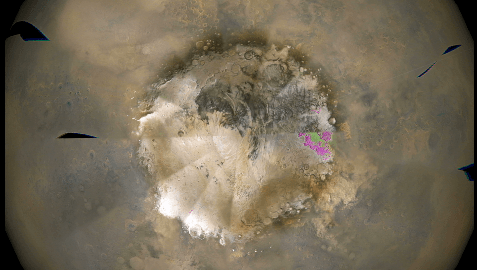If you think about it, those hypnotizing patterns of swirling clouds you see in TV weather reports are pretty amazing: satellites let us see what’s happening in the skies all over the world. But these days, that kind of global vision even goes beyond the Earth. The Mars Reconnaissance Orbiter makes daily weather observations of the Red Planet, and mission scientists regularly compile the pictures into movies that are available online. The result is that anyone can follow along as fierce dust storms rage across the plains of Mars, clouds cling to the peaks of towering volcanoes and polar ice advances and retreats.
On board the MRO is a wide-angle camera called the Mars Color Imager (MARCI) that scans the face of Mars in both visible and ultraviolet light. MARCI views Mars from pole to pole, snapping dozens of images every day that are combined into a global map with resolution comparable to weather satellites at home.
This daily weather report helps Mars explorers understand day-to-day events, as well as seasonal and annual changes on the Red Planet. Sometimes the weather watch also gives rover drivers a crucial warning when a storm might be headed in the direction of Spirit or Opportunity.
The weather images can be striking and intriguing. This animation shows the south pole of Mars during a period of about a month earlier this year, when storms raged along the retreating edge of frost in the polar cap. You can see giant, swirling clouds of dust, as well as the changing shape of the cap as it shrinks with the approach of Summer.
Malin Space Science Systems is the firm that built and operates MARCI for NASA’s Jet Propulsion Laboratory. They post weekly movies that show a spinning, global view of the most recent Martian weather. You never know what you’ll see each week, but a careful look often turns up water ice clouds, wind storms or the giant canyon Valles Marineris filled to the brim with dust.
The descriptions that Malin scientists write to accompany each movie are fascinating. They sound both as exotic as a science fiction novel–and as routine as your local weatherman’s report on the evening news. One sample:
“A large dust storm moved south down the Acidalia/Chryse/Xanthe corridor, partially spilling into eastern Valles Marineris at the beginning of the week. From there the storm moved over Thaumasia and Argyre, picking up intensity as it moved into the subtropics of Aonia and Icaria/Daedalia… Dust storms and water-ice clouds also formed in the northern mid-latitudes, with more notable activity occurring over Deuteronilus and Utopia. The increased amount of dust activity on the planet has created a haze that lingers in the atmosphere and has caused skies over both Opportunity and Spirit to be hazy during the past week.”
That’s why Mars fascinates. It’s an alien world that in some ways is tantalizing similar to home.
MARCI will be turned back on in early December after a hiatus of a few months. Previous weather movies are still online.


But isn’t “cold as hell” an oxymoron? 😉
I’m actually one of the three people that take turns writing these weather reports and making the little movies. It’s nice to know that there are people out there looking at them! You’d be surprised how much effort it takes for us to come up with different ways of saying “it was dusty on Mars” every week. 🙂
SeskaLien – the video is very interesting, and I’m sure many people appreciate it. Just a couple of quick questions – how close are the colors to what an astronaut would see looking out a clear spacecraft window near Mars? And also, have you ever made videos in violet or UV at the times when the phenomena called “blue clearing” occurred? (Have you ever even heard of that?)
Thanks!
But, “cold as Hell” is accurate, at least according to Dante…at least, the very center circle is ice.
TD—The colors are pretty close to what you would see if you were in orbit. Mars is a range of browns, dust clouds are pinkish, and water ice clouds are bluish-white. The MARCI UV bands are mainly used for ozone mapping, and haven’t been used to investigate the blue clearing phenomenon as far as I know.
How does conventional wisdom explain the global dust storms, anyway?
I’m just perplexed- the atmosphere on Mars is 1/100th the density of Earths atmosphere, so how then can a wind blow so sstrongly to loft that much dust? Where does the energy for those events come from, in a purely hydrodynamic weather model?
Just curious…
Mike H.
@mharratsc: The dust lofted by these storms is very, very fine-grained. Large storms are usually generated by strong temperature gradients, such as along the seasonal polar cap edges (like land breeze and sea breeze or katabatic winds on the Earth), as well as storms kicked up due to Hadley cell circulation and orographic effects (i.e. the Hellas basin, water ice clouds persisting over the large volcanoes, etc.). There are never really “global” dust storms; the more appropriate term used by the scientific community now is “planet-encircling dust event.” This is because the storms themselves are not planet-wide, but rather a coalescence of multiple regional storms leads to a large amount of dust being suspended in the atmosphere for an extended period of time.